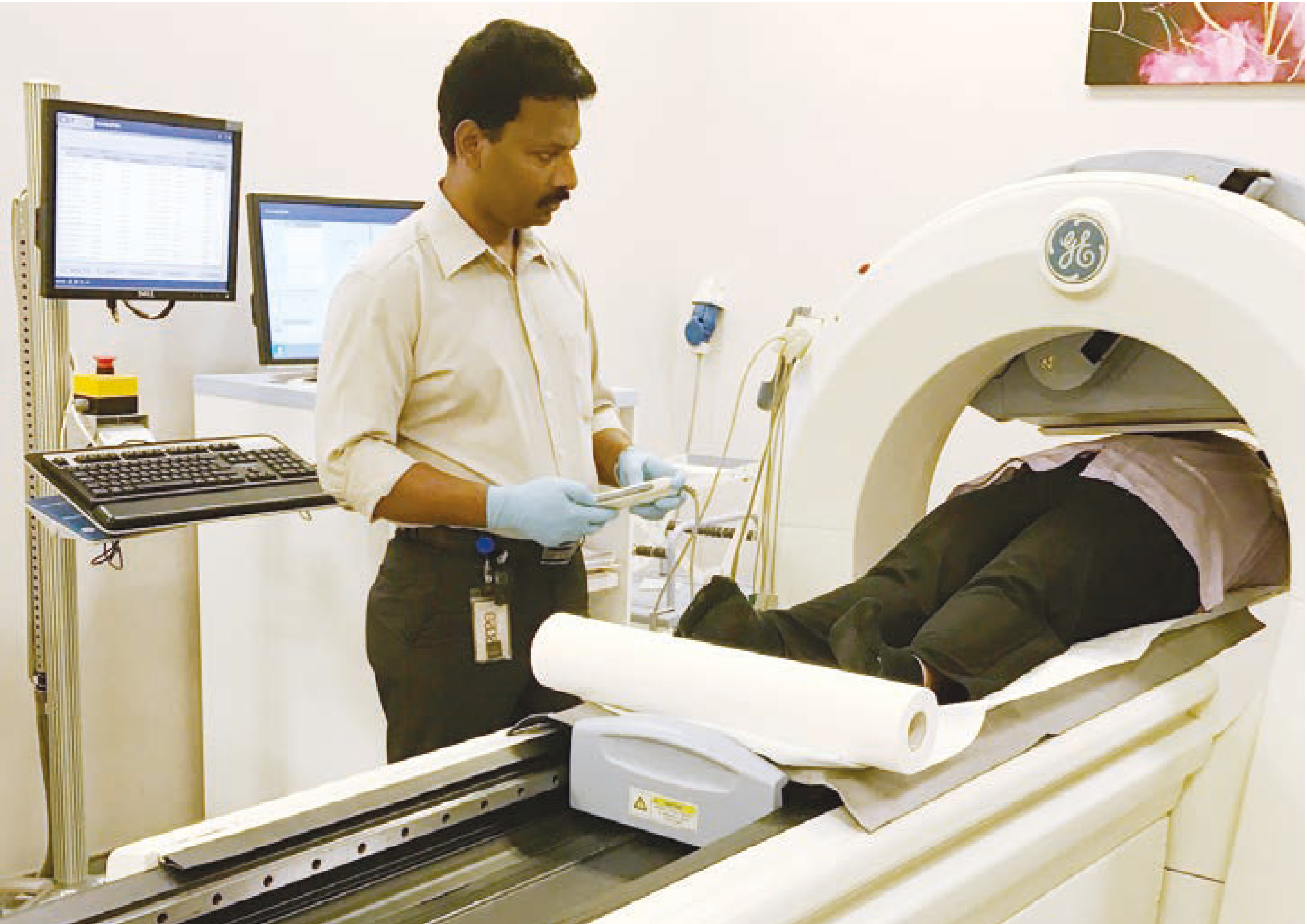What is a Pharmacological Stress Myocardial Perfusion Imaging Test?
The pharmacological stress myocardial perfusion imaging test assesses the blood flow to the heart muscle when the heart is made to work harder ('stressed'). This test determines the possibility of blockage in one or more coronary arteries. Blood flow in the heart is assessed by injecting a very small amount of a radioactive chemical, usually technetium or thallium, which is absorbed by the heart. The heart is then imaged using a special gamma camera.

Imaging table and the gamma camera used to captureimages of the heart.
To create an environment where the heart is stressed, patients usually undergo a treadmill exercise. However, some patients are unable to exercise due to reasons such as joint aches or poor general health. In such cases, the heart will be stressed via the injection of a drug that mimics the effects of exercise on the heart.
What is the Purpose of the Test?
Coronary arteries are blood vessels supplying the heart. They can be abnormally narrowed in a medical condition called atherosclerosis. For patients with atherosclerosis, there may not be enough blood flow to the heart during physical exertion, leading to symptoms of chest discomfort and shortness of breath.
The test assesses the blood flow to the heart and also gives the doctor an indication of the strength of your heart beat (the ejection fraction). These are the two most important pieces of information a doctor needs when evaluating a patient for heart disease.
What can I Expect?
The test is performed in the Nuclear Cardiology Laboratory. It consists of the stress phase and the rest phase, both of which are usually completed on the same day. However, in some cases, due to technical factors, it may be necessary to perform each phase on separate days.
Before the Test
Your height and weight will be taken and a small plastic tube or cannula is inserted into a vein on your hand for injection of the radioactive chemical.
To facilitate the attachment of electrocardiogram (ECG) electrodes to the chest, male patients will be asked to remove their shirt. Female patients may be asked to change into special gowns for the purpose of attaching electrodes. Once your blood pressure and baseline ECG are recorded, you will then proceed to the resting phase of the test.
During the Test
1. Resting Phase
The radioactive chemical is injected and shortly thereafter, you will be asked to lie facing upwards on the imaging table of the gamma camera for about 15 minutes. It is important to lie as still as possible for good images to be captured. After a 2-hour interval, you may proceed to the stress phase of the test.
2. Stress Phase
A medication will be given to you through the cannula over a period of 4 minutes. Your ECG and blood pressure will be monitored and a doctor will be present during this phase of the test. You should inform the doctor if transient side effects, such as flushing occur. When the drug infusion has completed, a radioactive chemical will be injected through the cannula. After about 30 to 45 minutes, images of your heart will be taken again with the gamma camera. You may consume some water during this period.
Additional 'prone' imaging, taking images of the heart while facing downwards on the imaging table may be needed in order to improve the diagnostic accuracy of the test.
Inform Your Doctor:
If you are taking any medications for high blood pressure and/or heart disease which may slow down tour heart rate. These medications should be omitted 24 to 48 hours prior to the test, except in specific clinical situations. Please check with your doctor about this.
If you have asthma. Asthmatic patients should not undergo this test as the medication can induce an asthma attack.
If you have a fever, a virus, or accompanying acute illnesses, you should not do the test.
Preparing for a Pharmacological Stress Myocardial Perfusion Imaging Test
Avoid caffeinated food and drinks, such as Coke, Coffee, Tea and Chocolate, for at least 12 hours before the test as caffeine may reduce the effectiveness of the injected medication. If you smoke, avoid smoking for at least 6 hours before the test.
What are the Potential Risks/Complications?
The pharmacological agent used is safe and welltolerated. Some people may experience minor side effects such as dizziness, headache, nausea, and chest discomfort. These symptoms usually last only a few minutes. Occasionally, for patients with pre-existing asthma, an asthmatic attack may occur. However, these symptoms are short-lived and will improve with treatment.
The risk of a major complication, including a heart attack, is very low. Medical staff present during the test will identify if there are problems in the early stages and terminate the test if needed.
The radioactive chemical given is safe and has no known immediate side effects. Exposure to radioactivity, theoretically, has a small risk of causing cancer. That risk is extremely small - for appropriately selected patients, the potential benefit of diagnosing and treating your heart condition far outweighs this small risk. Pregnant women should inform the doctor as they should not undergo this test.
When Will I Know the Results?
Your results will be made available during your next appointment with your doctor. Preliminary results will not be given on the day of your test. In the event of a very severe abnormality requiring urgent medical attention, appropriate measures will be taken, which may include either prompt admission to the hospital or rescheduling your appointment with your doctor to an earlier date.
